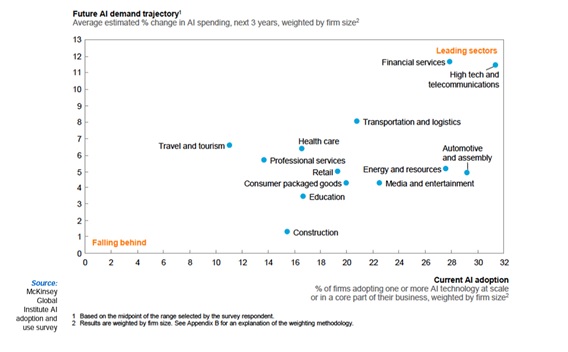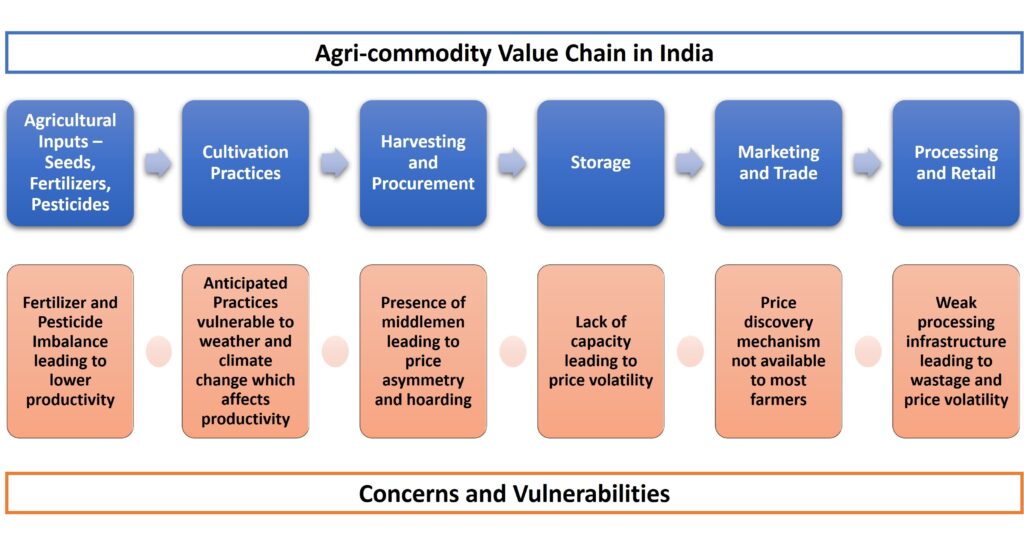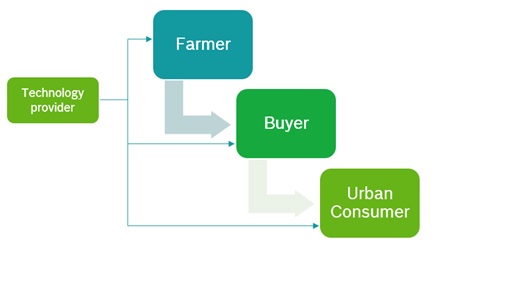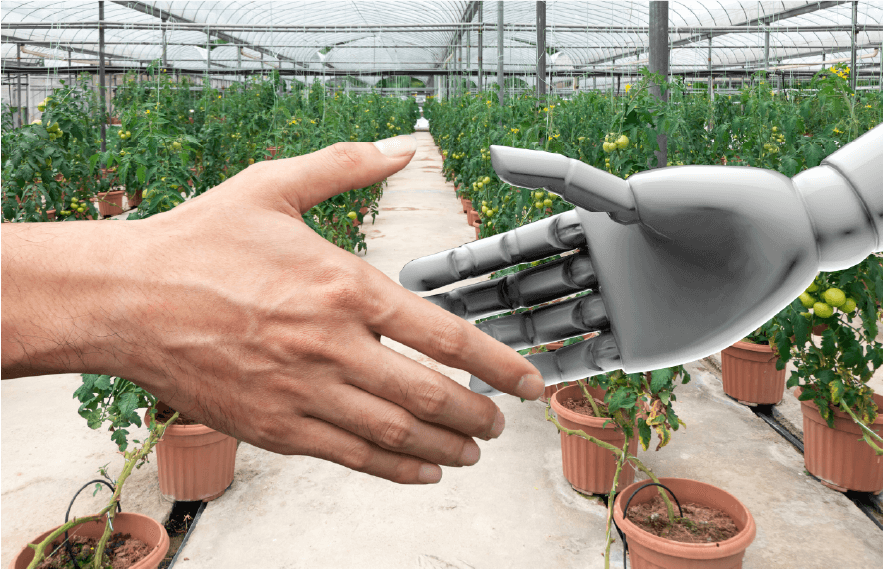Introduction
Agriculture is the primary source of livelihood for about 58% of India’s population. Unfortunately, the industry suffers from poor resource utilization, with the production quantum and productivity still being relatively low. However, IT intervention in specific areas of the value chain that add maximum value to all the players involved can go a long way in improving the Indian agriculture sector.
Agri-commodity Value Chain and Problems Faced in India
The Agricultural Commodity Value Chain refers to the people and their activities, which bring essential agricultural products like fruits, vegetables, cotton to the final consumer. The essential products go through various stages like processing, packaging, and distribution before reaching the markets.
However, multiple problems pose hurdles for the Indian agriculture sector, hindering the agri-commodity value chain. These are listed below:
- Despite making impressive progress and receiving government attention, the agriculture sector continues to be dependent on unpredictable variables, has a weak supply chain, and low productivity
- Degradation of land, reduction in soil fertility, increased dependence on inorganic fertilizers for higher production, rapidly dropping water tables, emerging pest resistance, and unpredictable climatic conditions are some of the several manifestations of India’s unsustainable agricultural practices
- The sector suffers from poor resource utilization, with the production quantum and productivity still being relatively low
- The use of water in agriculture continues to be high and sub-optimal, the practice of growing water-intensive crops and inefficient water management; Despite having just one-third of the gross cropped area under irrigation, agriculture consumes 89% of our extracted groundwater
AI in Indian Agricultural Sector: An Overview
The global population is estimated to increase by 35% by 2050, which means the agriculture production needs to double to meet consumption needs. However, several challenges need to be addressed to double the produce, which can be done with the help of AI. Some of the challenges that AI can solve are – inadequate demand prediction, lack of assured irrigation, overuse and misuse of pesticides and fertilizers, improvement in crop yield through real-time advisory, advanced detection of pest attacks, and prediction of crop prices to inform sowing practices.
The interesting point is that agriculture does not feature in the McKinsey Global Institute AI Adoption and Use Survey (image below). However, the Government of India is taking measures to make the field attractive to private sectors (according to the Annual Report 2018-19 released by NITI Aayog).

India was expected to have 90 million farmers who own smartphones as of 2020, and 299 million rural Indians were using the internet by the end of 2020. In addition, an Accenture study says that digital farming and connected farm services are expected to have impacted 70 million Indian farmers in 2020, adding $ 9 billion to farmer incomes.
Value Chain Analysis
Rather than looking at the agriculture sector as a whole, it would be more lucrative to segregate the industry based on the value chain, mainly consisting of Farmers, Buyers, and Urban Consumers. This would help in understanding where technology providers should intervene to generate maximum value.
In the 21st century, processors and retailers modernized their procurement systems (with corresponding traceability, auditing, and certification systems) to overcome information asymmetry, reduce transaction costs. In addition, they used it as a marketing tool to increase product differentiation and access to the high-quality raw material necessary to meet new demands.
New demands made to farmers, including getting higher yields for minimum input, ensuring better quality produce, or satisfying other types of standards, often required farm-level investments in new technologies.
Usually, the key mechanism for farms to access and adopt new technologies is through:
- co-operative societies with interlinked technology transfer
- triangular structures with technology suppliers and financial institutions
- vertically integrated production – vertical coordination in value chains
Technology transfer from buyers (companies that utilize farm produce) to farms occurs in an environment with imperfect credit and technology markets but depends on the surplus generated by the technology, the holdup opportunities in the value chain, and the type of technology.

Four Ways in Which Technology and AI can Help Improve Agri-Commodity Value Chain
The use of AI and related technologies have the potential to impact productivity and efficiency at different stages of the agricultural value chain:
- Soil health monitoring and restoration: Image recognition and deep learning models have enabled distributed soil health monitoring without the need for laboratory testing infrastructure.
- Increasing efficiency of farm mechanization: Image classification tools combined with remote and local sensed data could bring a revolutionary change in the utilization and efficiency of farm machinery in areas of weed removal, early disease identification, produce harvesting, and grading.
- Increasing the share of price realization to producers: Current low levels of price realization to farmers (as low as 20% in fruits and 19% in vegetables) are primarily due to ineffective price discovery and dissemination mechanisms, supply chain intermediary inefficiency, and local regulations. Predictive analytics using AI tools can bring more accurate supply and demand information to farmers, thus reducing information asymmetry between farmers and intermediaries. e-NAM Agricultural Census (with data on over 138 million operational holdings), AGMARKET, and over 110 million Soil Health Samples provide volumes of data required for any predictive modeling.
- Monitoring crop health and providing real-time action advisories to farmers: Varying weather patterns such as an increase in temperature, changes in precipitation levels, and groundwater density can affect farmers, especially in the rain-fed areas of the country. AI can be used to predict advisories for sowing, pest control, input control can help in ensuring increased income and providing stability for the agricultural community.
Role of Technology Providers: When and Where Do They Add Maximum Value?
Technology providers can provide their services to all the three major sections of the value chain. For example, farmers can be assisted in precision farming, buyers can be assisted in logistics, and urban consumers can be helped in understanding the origin of the produce.
The value of farm produce depends on how much the end consumer is willing to pay to procure it, based on the quality or the rarity of the product. Employing advanced technologies at the initial stages of production and protecting the crops against adverse weather conditions can help improve the quality of produce.
Farmers are not financially equipped to implement these technologies on their own. However, companies who purchase produce from the farmers can help them implement the technologies. So more value can be generated by the technology provider if they target the section of buyers who have more money to invest.

To give more control to the buyers and reduce the probability of farmers diverting the tech offered to different areas that would not benefit the buyer, technology specific to a crop could be developed.
Some inputs must be provided to farmers during every production period, such as seeds, fertilizer, pesticides, and packaging. These costs recur every year, and their benefits are realized in the contract year. Other technologies affect the production process beyond the current period, such as knowledge or training, equipment, or investments in traceability systems. These technologies provide long-term effects beyond what is realized in one production cycle. The transfer of technologies with short-term value effects is likely easier than technologies with longer-term benefits because the benefits are more likely to be captured in the contract period.
Conclusion
Based on the analysis, more value would be added to the value chain if the technology providers intervene at the level of the bulk buyers who purchase produce directly from the farmers. The more precision applied to farming practices, the more will be the value generated. This would help secure the demand for Indian agriculture products in the international market.
References:
Performance Assessment of Storage and Warehousing Industry in India
NITI Aayog Annual Report 2018-19, 2019-20
Feeding 9 Billion – National Geographic Article
McKinsey Global Institute: Artificial Intelligence the Next Digital Frontier
Forbes article – “For India’s Farmers It’s Agtech Startups, Not Government, That Is Key”
Statista Report: Number of Smartphone users in India 2015-2022
See how AI can improve Agricultural Productivity
Value Chain and Technology Transfer to Agriculture in Developing and Emerging Economies



